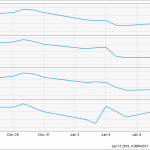Back at the end of October, US crude oil inventories hurt WTI oil once again as it came in higher than expected at 0.9 million barrels as opposed to the -2.6million barrels.
The fact of the matter is the oversupply that has been hurting WTI and Brent Oil since the end of June 2014.
Due mainly to U.S. Shale there has been an abundance of oil which has pressured prices lower and they have in fact collapsed by more than 50% from its peaks in early 2014.
Reacting to the weaker prices OPEC (Organization of Petroleum Exporting Countries) and other oil producing countries such as Russia agreed to cut production until the end of March 2018. This move injected a bit of life into oil which bounced back from its lows of $26 per barrel and throughout 2017 it has traded between $42 per barrel to this year’s high of $57.59 per barrel.
The reason behind the current stable mood now there is fear that a lack of supply which could push prices higher. In interview with Bloomberg in October, the ever influential Saudi Crown Prince Mohammed bin Salman said that he backed extending OPEC production cuts past the original date of March 2018.
His was not the only voice calling for the extension of production cuts, Russia President Vladimir Putin has also backed an extension to the very least until the end of 2018.













Leave A Comment